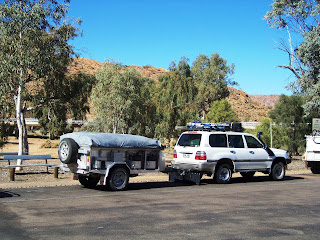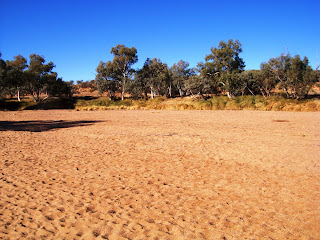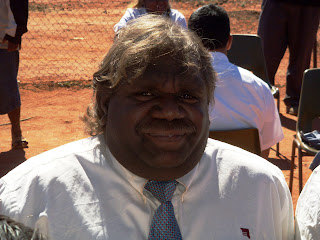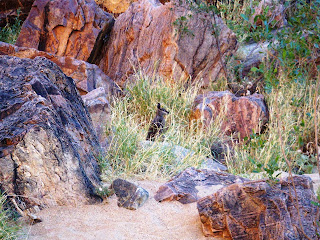Alice Springs, Northern Territory, Australia is located pretty much in the center of the continent. It is a mere 1500 km south of Darwin and about 1500 km north of Adelaide. Perth is about 2500 km to the west and Sydney is almost 2800 km to the east. In comparison to the USA -- it is almost the same distances as Salina, Kansas is to the N, S, E, and W extremes of the continental US. (Australia and the continental US are comparable in size.)

Alice (as it is called by the locals) has only 28,000 residents. But since it is the only town of any significance for almost 1500km in any direction, it provides transportation and shopping support for a very large area (over 800,000 square miles – of desert).

Over-the-road transportation takes on a whole new dimension. We think 18-wheel tractor-trailer rigs are big. I had to do the math twice to confirm the 78 wheels on this baby. They are called road trains.

It is primarily by reason of its enormity, along with the extreme heat, that the Outback is so impressively formidable.

Beauty and interest in New Zealand focus on water and vegetation. In the Australian Outback it is the rocks that are impressive. This mound of solid sandstone – Ayers Rock – is almost 1200 feet high and well over a mile from end to end. (Six miles in circumference)

Near the center of Alice is a small hill named Anzac Hill. I climbed to the top to get a better view of the town. Here I am on a beautiful clear winter morning on the side of Anzac Hill.

Since the Outback averages less than 5 inches of precipitation a year (less than half of what Utah gets), it is very dry and dusty. The utility vehicles are equipped with special air intake manifolds that pull the air from the top of the vehicle. They are also equipped with multiple spare tires and gas cans.

If you are going to stay in the Outback, you don’t want to sleep right on the ground (snakes and other undesirables like to cuddle in the cold desert nights). This vehicle is equipped with a car top tent. Just unfold it and POP – you can sleep on the car-top platform.

Trees and other woody shrubs grow plentifully in areas where there is water – occasional water. This river bed, like most in the area, last had flowing water in January 2009, prior to that it had been three years.

Even rental vehicles (that are authorized to “go bush”) are equipped with multiple spare tires. They also have spot lights and “roo bars” in the front.
Roo bars? Guess what they are for.

On Friday, after my meetings in Alice, I had a little time to climb some of the nearby mountains. They were mostly rock with a few bushes and wild grass.

Looking down from the top gave a good view of the desert floor below, with a typical unpaved road. The mountains in the distance are untamed. This picture reminded me a lot of Nevada.

Here is a close up picture of the road shown above. It isn’t much of a road at all, but it is used more than you would think.

Just so you don’t get the wrong impression, this picture is of a major roadway. (Unlike the last one, these roads are either named or numbered). We were travelling about 120 km/hr on this road when we hit a kangaroo that jumped out in front of us.

This is a picture of the springs for which Alice Springs got its name. It really isn’t a springs, it is just residual water left over from the last rain storm. This whole section of land is situated on a large layer of granite that prevents the water from percolating into the soil.

After climbing a few hills, I went for a long walk in the bush. This is what the trail I followed looked like most of the time. I chose to follow well marked trails because it is so easy to get lost in the bush.

There are hundreds of varieties of trees and shrubs in the Outback. Most that survive have either very hard and spindly leaves or waxy leaves (like the eucalyptus tree).

There is far more variety and color than you would expect. Variety in rocks, shrubs, trees, and terrain.

I found the Outback to be a beautiful desert with beautiful flowers and lots of variety in every direction and in every form. It is a land of extremes, similar to Africa.

The bush country of the Outback is full of wild life that has learned to adapt to the hot temperatures and the scarcity of water. This kangaroo is carrying a baby in its’ pouch, but it wouldn’t stand still for me to get a good picture.

It was too hot for the ants that made this nest when I took this picture. They were waiting out the sun, underground. The Outback really comes alive after the sun goes down.

This is a picture of a termite mound. They make these to help them survive the drowning floods, when it rains, and to stay cool during the heat of the day. It also protects them from their main preditors – ants.
(I’m the guy next to the mound – we had just finished a meeting with an aboriginal community called Alcoota)
It was while we were on our way to this community that we hit the kangaroo. We had traveled about a hour over a single lane road, and then turned on to a dirt road, when the roo jumped in from of us. Since we were going about 120 km/hr on dirt, there was little opportunity to do anything. It smashed in the front of the car, killed the roo and ruined the rest of our day …

Our purpose in going to Alcoota was to discuss the English language program that we prepared for the aboriginals to use in their community center.

This is a picture of the community center we met in. We had only a handful of Aboriginals that showed up the for training.

The next day we went to another bush community, named Mulga Bore. A Mulga is a native tree that the Aboriginals use for medicinal purposes.

We conducted church services in Mulga Bore. All of the men came dressed in the Sunday best – white shirts and ties.

Even the children were dressed for church. The Aboriginals are very soft spoken and somewhat shy. They are very anxious to please and are taught to be obedient. (We provided a light lunch afterward)

This gentleman, Gary Bird, is the leader of the Mulga Bore community. Because they are so respectful of sacred things, they want to be their very best on Sunday or when attending any church function.

Likewise they expected us to do the same. Consequently, those of us that had suits wore them.

Once I understood how reverent they are of sacred things, I nolonger felt over dressed in my suit. Actually, it felt quite natural for the occation.

The outback extends forever. Except for the absence of sagebrush, this section reminded me a lot of Wyoming.

Other parts reminded me of Idaho.

This picture could just as well have been taken in New Mexico.

But more than anywhere else, I found many of the sites around Alice Springs to look a lot like southern Utah.

This area, however, reminded me a little bit of southern Idaho.

To me this picture could just as easily been taken at Cedar Breaks in southern Utah.

The Wallabies, on the other hand, were completely unique. Very shy, they hid themselves in the tall grass most of the time.

This was one of my lucky shots; one out of a twelve isn’t too bad.

On Monday, I had some time to do a little more hiking in the mountains.

In some sections I had to pick my way through the rocks as I climbed the summit.

In other areas, the layers of shale formed steps up the side of the mountain.

Sometimes my path led me through desolate valleys and woodlands.

At other times I followed dried up river beds, hopping from rock to rock or boulder to boulder.

Sometimes the distant scenery looked almost Alpine.

At other times there was no mistaking that I was in a forbidding desert.

Sometimes the trail led me to a small oasis-like park.

But most of the time it was quite dry and crusty.

Almost all of my pictures were taken when I was out walking. The trails I followed were as varied as everything else.

I saw beautiful fluffy flowers with names that I’m not familiar with ...

And flowering succulents in the desert sands ...

Beautifully colored birds ...

Terrain as rugged, jagged, and rough as anywhere ...

Even the simple Aboriginal cave paintings added to the variety and intrigue.

So, if it is adventure you want ... meet me just 1500 kilometres north of Adelaide (but only in the winter time -- summertime tempertures hover around 115 to 120 F).
Oh yeah, ask me about the flies some time, when you have an hour to spare.
 Beauty and interest in New Zealand focus on water and vegetation. In the Australian Outback it is the rocks that are impressive. This mound of solid sandstone – Ayers Rock – is almost 1200 feet high and well over a mile from end to end. (Six miles in circumference)
Beauty and interest in New Zealand focus on water and vegetation. In the Australian Outback it is the rocks that are impressive. This mound of solid sandstone – Ayers Rock – is almost 1200 feet high and well over a mile from end to end. (Six miles in circumference)